
Your Mountain is Waiting © Steven B. Smith
When the real estate bubble burst in 2008, a new genre of photography emerged: Foreclosure Porn. The pictures featured homes—sometimes entire subdivisions—that appeared to have been abandoned in the middle of the night; vines now crept up walls, empty swimming pools had filled with leaves, “for sale” signs tilted above mangy lawns.
If those images gave us a glimpse at our bad breakup with real estate, Steven B. Smith’s new book, Your Mountain is Waiting, shows us the crazy-in-love rebound stage, complete with the big-spending and third-date certainty that this time things will be different.
Smith, a professor of photography at the Rhode Island School of Design who has a Guggenheim Fellowship under his belt, grew up in one of Utah’s more conservative communities—where his family still lives—and much of his work is rooted there. His razor-sharp book of street photography, Waiting Out the Latter Days, focuses on small-town Utah parade-watchers, picnic-goers, and rodeo boys, and reads as a sort of Mormon version of The Americans; other work looks at Colorado City, the isolated town once run by the polygamist—and convicted felon—Warren Jeffs. In Your Mountain is Waiting, Smith returns to Utah to shoot a new cast of characters: suburban homes rising quixotically in the state’s southern foothills.

Your Mountain is Waiting © Steven B. Smith
Smith finds absurdist gold in these hills. Why is that multi-ton boulder sitting on a newly constructed patio as if it fell from a sci-fi film? Why do those windows open onto a rock wall? Why would that old man be sitting in a lawn chair spraying the vast desert dirt with a skimpy garden hose? Why, indeed. The book’s color photographs often play like quiet, well-constructed Zen koans, with their artful serenity belying complex meditations on consumerism, class, conformity, and the continuous friction with nature that fuels the American dream.
What initially drew Smith to the project, he says, was something less abstract: He began to notice suburban homeowners “building small versions of the existing landscape in their own yards.” This intrigued him in part because the actual landscape—the majestic hills, the dramatic rock structures, the reds and oranges of the desert earth—was often a five-minute stroll from the “landscape taxidermy” homeowners were creating on their emerald-green lawns. “I wanted to show how they expressed their love and appreciation for nature—how they paid homage to the land—even as they paved over it.”

Your Mountain is Waiting © Steven B. Smith
And so in the strange suburban world that Smith reveals, we see rebar and plaster being fabricated into huge ornamental yard boulders…while real boulders sit just hundreds of feet in the distance. We see mountain-shaped horizon lines being cut into stucco walls that mimic the actual horizon line directly behind them, tarps that will turn into ponds, rolled-up sod that will soon lie beneath six-burner Weber grills.
While plenty of other photographers have cast a sharp eye at the cracks in the suburban dream—most notably Bill Owens in his classic 1973 examination, Suburbia—it’s unlikely that many have spent as much time as Smith has studying freshly minted suburban yards. He returned to the foothill subdivisions some 40 times over the course of 12 years, shooting more than 15,000 frames. (“Five hundred negatives,” he explains, “the rest digital.”)
But Smith’s inspired twist on the canon of suburban imagery is to turn the objects that most photographers use to set the stage for their pictures—the grass, the rocky pathway, the retaining wall—into characters in their own right. “One of the things I’m trying to show is how homeowners anthropomorphize these objects and project their values onto inanimate things,” he says.

Your Mountain is Waiting © Steven B. Smith
Sometimes, those “values” play out as over-the-top consumerism (the in-ground pool behind the lake house, for instance) or old-fashioned my-faux-boulder-is-bigger-than-your-faux-boulder neighborly one-upsmanship. But while his pictures are often funny, Smith isn’t simply poking fun. “I try be aware of the different ways people show their appreciation for nature, of their good intentions, even as they might be doing destructive things.”
It’s no easy trick to layer American I-can-have-it-all arrogance atop an acknowledgment that the picket-fence dream is still worth chasing, all the while never losing sight of the endearingly futile way that humans attempt to “own” nature. But, somehow, Smith pulls it off. Yes, America’s tendency to crossbreed consumption with conformity has long produced homes both over-the-top and grotesque. But Smith isn’t out to shoot fish in a suburban barrel. In Your Mountain is Waiting, Smith’s images—clear-eyed, sharp-tongued, but also big-hearted—catch something far more nuanced, far more ambitious.

Your Mountain is Waiting © Steven B. Smith

Your Mountain is Waiting © Steven B. Smith

Your Mountain is Waiting © Steven B. Smith

Your Mountain is Waiting © Steven B. Smith

Your Mountain is Waiting © Steven B. Smith
By Bill Shapiro
Bill Shapiro is the former editor-in-chief of LIFE magazine and the author of the recently published book, What We Keep.
Your Mountain is Waiting, Photography by Steven B. Smith
Essay by Lydia Millet / Interview with Katie Lee-Koven
Radius Books / 80 pages / $44.00


